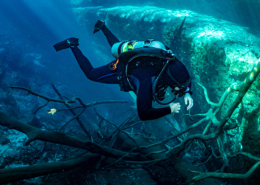The Importance of Proper Weighting
By Gemma Smith
So you have certified as a new diver and want to get in the water diving and practicing as soon as possible. You remember from your introductory scuba diving course all the main skills you learned. There is just so much fun stuff to work on and improve upon when diving! It’s all too easy in the enthusiasm of wanting to get UNDER the water to forget that a large part of what makes your life easier as a diver takes place BEFORE you even first start your descent. Proper weighting is, without a doubt, one of the most important requirements for the competent diver. It, unfortunately, seems to be one of the most commonly overlooked though. I worked for a year in one of the busiest dive centres in the Caribbean. The problem that reared its ugly head, again and again, was novice, and sometimes even experienced divers, having problems because of incorrect weighting. If you are willing to take the time though it is actually one of the easier adjustments to make. Get it right and it will without question bring on your skills as a diver in leaps and bounds.
Why is weighting so important anyway?
Proper weighting really is the solid base on which we build safe diving skills. It allows us to fine tune and control our buoyancy. This means controlled descents. It means a smooth and well-positioned body position on the dive. It also allows a slow and steady ascent and safety stop at the end of the dive. Correct weight means less drag, better trim, and normally a reduction in gas consumption (SAC rate). Too much weight, on the other hand, has the risk of a fast descent. This may result in mask squeeze, ear barotrauma, or in going deeper than your planned maximum depth because of too speedy a descent. It will also make buoyancy control much more difficult. An over-weighted diver needs to add more air to their BCD to try and get neutral, but this will only force them to make more buoyancy adjustments as the air expands and contracts with depth changes. Too little lead, on the other hand, has issues if you don’t actually have enough weight to safety ascend slowly and hold your stops. As Goldilocks said about the Three Bears’ porridge in the famous children’s story, weighting really needs to be ‘neither too much or too little, but just right’.
So where do I go from here?
The easiest way to check your weighting is to do a weight check at the beginning and end of your dive. It’s simple:
- Once floating comfortably in the water at the start of your dive make sure your mask is on and your regulator is in your mouth. While in the vertical position take a breath in. No need for a large lungful of air, just a normal breath.
- Hold your breath (while it is NEVER ok to do this underwater, for checks like this one on the surface it is safe).
- Use your BCD inflator to dump all the air from your BCD. Make sure you keep hold of your inflator so if you start to sink unexpectedly quickly you can add more air and become positively buoyant again. For those divers wearing drysuits, fully open your exhaust dump, and vent your drysuit of air.
- The general idea is that when properly weighted you will float at eye level at the surface while holding a normal breath
- Now breath fully out. You should sink past eye level and start to slowly descend on that exhalation. Although it is tempting, try and resist the urge to fin or scull with your hands. Doing this will not give you a real measure of whether or not the weight you have on is correct.
- Return to the surface of the water and repeat the exercise with less weight. A properly weighted diver should just be able to get under the water when they exhale. Your descent should be in control and stable, not a plummet to the depths.
- If you found you couldn’t descend comfortably add more weight in small increments. Keep adding until you can complete the weight check with ease.
Do a weight check at the beginning of the dive to make sure you can start the descent. Don’t forget though that your scuba cylinder will become more buoyant throughout your dive as you use the air. Perfectly weighted at the start will mean underweighted at the end, so adjust accordingly. The aim is to be able to hold your safety stop easily at the end of your dive, with little or no air in your BCD. Also, think about whether you are diving a steel or aluminium tank. While steel will have a slight change in weight when less full of air, the change in weight of an aluminium cylinder is more significant.
My weight is now perfect so I’m done, right?
Well, not exactly. To be weighted properly is a continual trial of experimentation and adjustments. Change exposure suits or what you are wearing, change the cylinder size or gear configuration, or change the environment? What you need in terms of weight will change. A thicker wetsuit or more thermals under a drysuit means you will need more weight in order to sink. Diving in fresh water for the first time when you normally dive in the sea will mean less weight. After all, seawater is denser than fresh. Achieving proper weighting is an evolving process, and one that you will probably adapt and change many times over your dive life. More diving experience and becoming more relaxed as a diver may even result in a change of weight, as your SAC rate goes down over time. Like all the skills we have in our diving toolbox, just completing them once is not enough. Repetition and fine-tuning is needed to truly become capable and confident as divers. While a simple weight check may seem unnecessarily basic for the more experienced diver, it is part of the solid foundations we first learned as new divers. It is these entry-level skills that enable more advanced and complex additions to be competently added to our diving repertoire over time.










Plaats een Reactie
Meepraten?Draag gerust bij!